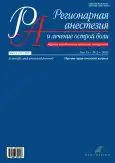Regional scalp block – the key analgesic element of anesthesia for supratentorial craniotomy
- 作者: Kulikov A.S.1, Tere V.A.1, Imaev A.A.1, Lubnin A.Y.1
-
隶属关系:
- Burdenko National Medical Research Center of Neurosurgery
- 期: 卷 15, 编号 2 (2021)
- 页面: 119-126
- 栏目: Reviews
- URL: https://journals.rcsi.science/1993-6508/article/view/90087
- DOI: https://doi.org/10.17816/1993-6508-2021-15-2-119-126
- ID: 90087
如何引用文章
详细
This paper presents the key data on the effectiveness and safety of the regional anesthesia of the scalp, also known as the scalp block, for providing perioperative analgesia for supratentorial craniotomy. The authors describe the technique and its limitations and also trace the implementation of the scalp block method into the routine practice of the largest Russian neurosurgical clinic based on personal experience, results of the own research, and analysis of literature data.
作者简介
Alexander Kulikov
Burdenko National Medical Research Center of Neurosurgery
Email: akulikov@nsi.ru
ORCID iD: 0000-0002-2852-6544
старший научный сотрудник
俄罗斯联邦, 4th Tverskaya-Yamskaya, 16, 125047, MoscowValentina Tere
Burdenko National Medical Research Center of Neurosurgery
Email: valentinary@mail.ru
ORCID iD: 0000-0003-4247-8953
俄罗斯联邦, 4th Tverskaya-Yamskaya, 16, 125047, Moscow
Alexander Imaev
Burdenko National Medical Research Center of Neurosurgery
Email: aimaev@nsi.ru
ORCID iD: 0000-0003-4395-1327
MD, PhD
俄罗斯联邦, 4th Tverskaya-Yamskaya, 16, 125047, MoscowAndrey Lubnin
Burdenko National Medical Research Center of Neurosurgery
编辑信件的主要联系方式.
Email: lubnin@nsi.ru
ORCID iD: 0000-0003-2595-5877
俄罗斯联邦, 4th Tverskaya-Yamskaya, 16, 125047, Moscow
参考
- Lubnin AY, Imaev AA, Solenkova AV. The problem of acute postoperative pain in neurosurgical patients. Regional anesthesia and acute pain management. 2016;10(4):282–290. doi: 10.18821/1993-6508-2016-10-4-282-290 (In Russ).
- Tsaousi GG, Logan SW, Bilotta F. Postoperative Pain Control Following Craniotomy: A Systematic Review of Recent Clinical Literature. Pain Pract. 2017;17(7):968–981. doi: 10.1111/papr.12548
- Nemergut EC, Durieux ME, Missaghi NB, Himmelseher S. Pain management after craniotomy. Best Pract Res Clin Anaesthesiol. 2007;21(4):557–573. doi: 10.1016/j.bpa.2007.06.005
- Gruenbaum SE, Meng L, Bilotta F. Recent trends in the anesthetic management of craniotomy for supratentorial tumor resection. Curr Opin Anaesthesiol. 2016;29(5):552–557. doi: 10.1097/ACO.0000000000000365
- Hansen MS, Brennum J, Moltke FB, Dahl JB. Pain treatment after craniotomy: where is the (procedure-specific) evidence? A qualitative systematic review. Eur J Anaesthesiol. 2011;28(12): 821–829. doi: 10.1097/EJA.0b013e32834a0255
- Salalykin VI. Mestnoe obezbolivanie. In: Manevich AZ, Salalykin VI, editors. Neiroanesteziologiya. Moscow: Meditsina; 1977. P:120–129.
- Pinosky ML, Fishman RL, Reeves ST, et al. The effect of bupivacaine skull block on the hemodynamic response to craniotomy. Anesth Analg. 1996;83(6):1256–1261. doi: 10.1097/00000539-199612000-00022
- Osborn I, Sebeo J. “Scalp block” during craniotomy: a classic technique revisited. J Neurosurg Anesthesiol. 2010;22(3):187–194. doi: 10.1097/ANA.0b013e3181d48846
- Costello TG, Cormack JR, Hoy C, et al. Plasma ropivacaine levels following scalp block for awake craniotomy. J Neurosurg Anesthesiol. 2004;16(2):147–150. doi: 10.1097/00008506-200404000-00007
- Costello TG, Cormack JR, Mather LE, et al. Plasma levobupivacaine concentrations following scalp block in patients undergoing awake craniotomy. Br J Anaesth. 2005;94(6):848–851. doi: 10.1093/bja/aei135
- Nguyen A, Girard F, Boudreault D, et al. Scalp nerve blocks decrease the severity of pain after craniotomy. Anesth Analg. 2001;93(5):1272-1276. doi: 10.1097/00000539-200111000-00048
- Ayoub C, Girard F, Boudreault D, et al. A comparison between scalp nerve block and morphine for transitional analgesia after remifentanil-based anesthesia in neurosurgery. Anesth Analg. 2006;103(5):1237-1240. doi: 10.1213/01.ane.0000244319.51957.9f
- Guilfoyle MR, Helmy A, Duane D, Hutchinson PJ. Regional scalp block for postcraniotomy analgesia: a systematic review and meta-analysis. Anesth Analg. 2013;116(5):1093–1102. doi: 10.1213/ANE.0b013e3182863c22
- Wardhana A, Sudadi S. Scalp block for analgesia after craniotomy: A meta-analysis. Indian J Anaesth. 2019;63(11):886–894. doi: 10.4103/ija.IJA_315_19
- Dobrodeyev AS, Salalykin VI, Tenediyeva VD, et al. Locoregional anesthesia as an analgesic component of anesthesiological provision of neurosurgical interventions into the brain. Russian journal of Anaesthesiology and Reanimatology. 2005;(3):4–8. (In Russ).
- Lubnin AY, Kulikov AS, Gavrilov AG, Kobyakov GL. Awake craniotomy. Russian journal of Anaesthesiology and Reanimatology. 2012;(4):28–37. (In Russ).
- Kulikov A, Lubnin A. Anesthesia for awake craniotomy. Curr Opin Anaesthesiol. 2018;31(5):506–510. doi: 10.1097/ACO.0000000000000625
- Imaev AA, Dolmatova EV, Lubnin AY. Comparative evaluation of pre-emptive analgesia with xefocam, ropivacaine, and durogesic transdermal therapeutic system in patients after craniotomy. Russian journal of Anaesthesiology and Reanimatology. 2010;(4):15–19. (In Russ).
- Kulikov A, Tere V, Sergi PG, et al. Preoperative Versus Postoperative Scalp Block Combined With Incision Line Infiltration for Pain Control After Supratentorial Craniotomy. Clin J Pain. 2021;37(3):194–198. doi: 10.1097/AJP.0000000000000905
- Arefiev AM, Lubnin AY, Kulikov AS. Dexmedetomidine vs clonidine. The best medication of prevention of hemodynamic response during awakening after craniotomy. Regional anesthesia and acute pain management. 2018;12(4):222–226. doi: 10.17816/1993-6508-2018-12-4-222-226 (In Russ).
- Imaev AA, Dolmatova EV, Kulikov AS, Lubnin AY. Using of transdermal therapeutic system Durogesic® for acute postoperative pain therapy in patients after craniotomy. Regional anesthesia and acute pain management. 2015;9(4):32–38. (In Russ).
补充文件








